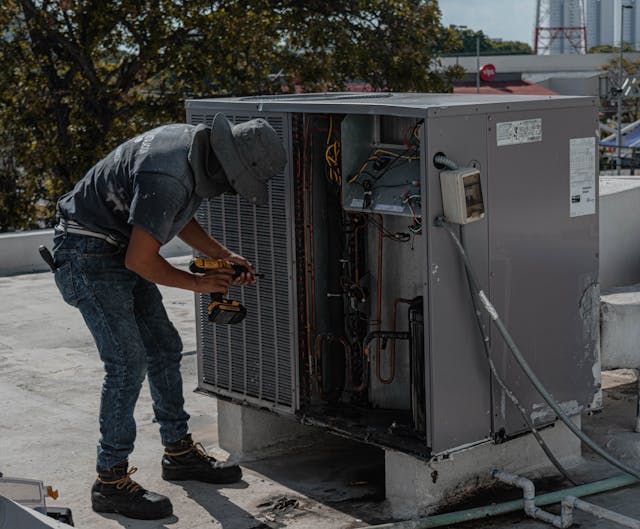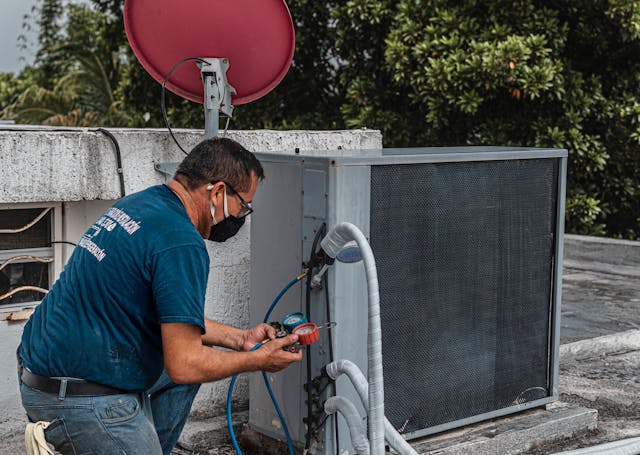HVAC Payroll & Prevailing Wage Bookkeeping: Ensuring Compliance & Accuracy


The HVAC industry faces unique challenges in managing payroll and ensuring compliance with prevailing wage requirements on government projects. HVAC Payroll & Prevailing Wage regulations create a complex web of federal, state, and local requirements that contractors must navigate to avoid costly penalties and maintain eligibility for lucrative public sector contracts. With government construction projects representing billions of dollars in annual opportunities, proper prevailing wage payroll management has become essential for HVAC contractors seeking sustainable growth and a competitive advantage.
The intersection of specialized HVAC labor classifications, varying project locations, and constantly changing wage determinations creates a perfect storm of compliance challenges. Contractors who fail to implement robust systems for tracking, calculating, and reporting prevailing wages often face audits, penalties, and potential debarment from future government work. Understanding these complexities and implementing effective solutions is crucial for any HVAC contractor serious about participating in the public sector marketplace.
Understanding HVAC Payroll & Prevailing Wage Fundamentals
HVAC Payroll & Prevailing Wage systems are governed by federal legislation, primarily the Davis-Bacon Act and related state laws, which require contractors working on government-funded projects to pay workers at least the locally prevailing wages and fringe benefits for similar work in the area. These laws were designed to protect local wage standards and ensure fair competition among contractors bidding on public projects.
Prevailing wages are determined through wage surveys conducted by the Department of Labor or state agencies, establishing minimum hourly rates for specific job classifications in designated geographic areas. For HVAC contractors, this means understanding wage determinations for various trades, including HVAC mechanics, installers, sheet metal workers, pipefitters, and apprentices. Each classification has specific wage rates that may include base wages, fringe benefits, and overtime premiums.
The complexity increases when considering that prevailing wage rates can vary significantly between counties, cities, and even specific project types. A commercial HVAC project in downtown Chicago will have different wage requirements than a school renovation in rural Illinois. Additionally, these rates are updated regularly, sometimes multiple times per year, requiring contractors to stay current with the latest determinations to ensure ongoing compliance.
Why HVAC Contractors Struggle with Payroll & Prevailing Wage Compliance

HVAC contractors face several unique challenges that make prevailing wage compliance particularly difficult to manage. The mobile nature of HVAC work means crews often travel between multiple jurisdictions within a single pay period, each potentially having different prevailing wage requirements.
A technician might work on a federal project on Monday, a state project on Tuesday, and private commercial work for the rest of the week, requiring careful tracking and calculation of different wage rates.
The skilled nature of HVAC work also creates classification challenges. Workers may perform duties that span multiple prevailing wage classifications within a single project. An HVAC mechanic may also perform electrical work, sheet metal fabrication, or general construction tasks, each of which may require different wage rates. Determining the appropriate classification and allocating time correctly becomes a complex bookkeeping challenge.
Many HVAC contractors also struggle with the administrative burden of certified payroll and prevailing wage reporting requirements. Weekly certified payroll reports must be submitted with detailed information about each worker, hours worked, wages paid, and fringe benefits provided. These reports carry legal weight and must be signed under penalty of perjury, making accuracy critical.
Essential HVAC Payroll & Prevailing Wage Bookkeeping Components

Effective HVAC payroll and prevailing wage bookkeeping requires several critical components working in harmony. First, a comprehensive worker classification system must accurately identify each employee's primary and secondary job functions, ensuring the proper application of wage rates. This system should account for apprentices, journeymen, and specialists within each trade category.
Time tracking systems must capture not only total hours worked but also specific project assignments, locations, and tasks performed. This granular data collection enables the accurate allocation of hours to the appropriate prevailing wage classifications, ensuring compliance with complex reporting requirements. Modern systems should integrate seamlessly with project management software to eliminate duplicate data entry and reduce errors.
Prevailing wage certified payroll preparation requires sophisticated calculation engines that can handle multiple wage rates, benefit allocations, and compliance requirements simultaneously. The system must calculate regular and overtime hours, apply appropriate wage rates based on project location and worker classification, and track fringe benefit payments or cash equivalents.
Documentation management is another crucial component, as contractors must maintain detailed records to support all wage calculations and payments. This includes timesheets, payroll registers, benefit payment records, and copies of all certified payroll reports. These records must be readily accessible for audits and maintained for specified retention periods.
Technology Solutions for HVAC Payroll & Prevailing Wage Compliance
Modern technology solutions have revolutionized prevailing wage payroll services by automating many previously manual processes and reducing the risk of costly errors. Advanced payroll systems now include built-in prevailing wage databases that automatically update with the latest federal and state wage determinations, ensuring contractors always have access to current rates.
Mobile time tracking applications enable field workers to clock in and out, automatically capturing GPS coordinates, project codes, and task classifications. This real-time data collection eliminates the need for paper timesheets, providing immediate visibility into labor allocation across multiple projects and locations.
Integrated payroll platforms can automatically calculate complex prevailing wage scenarios, including multi-classification workers, overlapping projects, and varying benefit requirements. These systems generate certified payroll reports in the required formats and maintain audit trails for all calculations and adjustments.
Cloud-based solutions provide additional benefits by ensuring data accessibility from any location while maintaining security and backup protocols. Project managers can monitor labor costs and compliance status in real-time, making informed decisions about resource allocation and project management.
Common HVAC Payroll & Prevailing Wage Compliance Mistakes

Several recurring mistakes plague HVAC contractors in their efforts to comply with prevailing wage requirements. Misclassification of workers represents one of the most common and costly errors. Contractors often default to using general laborer rates instead of the appropriate skilled trade classifications, resulting in underpayment of wages and potential penalties.
Inadequate record-keeping practices create another significant risk area. Many contractors fail to maintain sufficient documentation to support their wage calculations during audits. Missing timesheets, incomplete benefit records, or poorly documented job classifications can trigger investigations and penalties even when workers were paid correctly.
Geographic confusion also causes frequent problems, particularly for contractors working across multiple jurisdictions. Using the wrong county's wage determination or failing to recognize when projects cross jurisdictional boundaries can result in systematic underpayment of wages.
Fringe benefit calculation errors represent another common pitfall. Contractors may incorrectly calculate benefit rates, fail to provide adequate benefits, or improperly document benefit payments. The complex interaction between prevailing wage benefit requirements and existing company benefit programs requires careful analysis and ongoing monitoring.
Best Practices for HVAC Payroll & Prevailing Wage Management
Successful HVAC payroll and prevailing wage management begins with establishing clear policies and procedures for all aspects of prevailing wage compliance. These procedures should cover worker classification, time tracking, payroll calculation, reporting, and record retention. Regular training ensures all personnel understand their roles and responsibilities in maintaining compliance.
Implementing robust internal controls helps prevent errors and ensures consistent application of prevailing wage requirements. Regular audits of payroll calculations, worker classifications, and certified payroll reports can identify potential issues before they become costly problems. Cross-training multiple employees in prevailing wage procedures provides backup coverage and reduces the risk of compliance lapses.
Maintaining strong relationships with labor compliance consultants and legal counsel provides access to expertise when complex situations arise. These professionals can assist with worker classification questions, audit responses, and regulatory interpretation issues that may exceed the internal capabilities of their clients.
Regular system updates and maintenance ensure that payroll systems continue to meet evolving compliance requirements. This includes updating wage determination databases, modifying calculation formulas, and adjusting reporting formats in response to changing regulations.
Benefits of Proper HVAC Payroll & Prevailing Wage Management
Effective prevailing wage payroll management delivers numerous benefits beyond simple compliance. Proper systems help contractors avoid penalties, which can range from back wages and interest to complete debarment from federal contracting opportunities. These penalties can be devastating to HVAC contractors who depend on government projects for significant revenue.
Accurate prevailing wage management also improves bidding accuracy and project profitability. Contractors with reliable wage calculation systems can develop more precise cost estimates, leading to competitive bids that maintain healthy profit margins. This accuracy advantage becomes particularly valuable in competitive bidding environments where small cost differences determine contract awards.
Strong compliance records enhance contractor reputation and open doors to additional government contracting opportunities. Agencies often consider past performance and compliance history when evaluating contractor qualifications, making a clean compliance record a valuable business asset.
HVAC Payroll & Prevailing Wage compliance represents both a significant challenge and a tremendous opportunity for contractors in the heating, ventilation, and air conditioning industry. The complexity of managing multiple wage classifications, varying project locations, and detailed reporting requirements demands sophisticated systems and procedures that go far beyond traditional payroll processing.
Contractors who invest in proper systems, training, and expertise position themselves for success in the lucrative government contracting marketplace while avoiding the costly penalties associated with compliance failures. The combination of technology solutions, best practices, and ongoing attention to regulatory changes creates a foundation for sustainable growth and competitive advantage.
The path forward requires commitment to excellence in compliance management, but the rewards justify the investment. With proper prevailing wage compliance systems in place, HVAC contractors can confidently pursue government projects while maintaining the accuracy and documentation necessary to support their operations during audits and inspections.
Frequently Asked Questions
What HVAC workers are subject to prevailing wage requirements?
All HVAC workers performing construction, renovation, or repair work on government-funded projects are subject to prevailing wage requirements.
This includes HVAC mechanics, installers, sheet metal workers, pipefitters, apprentices, and helpers. The specific classifications depend on the tasks performed and the applicable wage determination for the project location.
How do HVAC payroll & prevailing wage rates get determined?
HVAC prevailing wage rates are determined through surveys conducted by the U.S. Department of Labor or state agencies. These surveys collect wage data from contractors and unions in specific geographic areas to establish minimum wage rates for various job classifications. Rates are updated regularly and published as wage determinations that specify minimum hourly wages and fringe benefit requirements.
What records must HVAC contractors maintain for payroll & prevailing wage compliance?
HVAC contractors must maintain comprehensive records, including certified payroll reports, original timesheets, payroll registers, benefit payment documentation, worker classification records, and copies of applicable wage determinations. These records must be kept for at least three years and made available for inspection by government agencies upon request.
What penalties do HVAC contractors face for payroll & prevailing wage violations?
Penalties for prevailing wage violations can include payment of back wages with interest, civil penalties, liquidated damages, and potential debarment from future government contracts. Willful violations may result in criminal prosecution. The severity of penalties often depends on the scope of the violations, the contractor's cooperation, and their history of previous compliance issues.
Lorem ipsum dolor sit amet, consectetur adipiscing elit. Donec ullamcorper mattis lorem non. Ultrices praesent amet ipsum justo massa. Eu dolor aliquet risus gravida nunc at feugiat consequat purus. Non massa enim vitae duis mattis. Vel in ultricies vel fringilla.
Introduction
Mi tincidunt elit, id quisque ligula ac diam, amet. Vel etiam suspendisse morbi eleifend faucibus eget vestibulum felis. Dictum quis montes, sit sit. Tellus aliquam enim urna, etiam. Mauris posuere vulputate arcu amet, vitae nisi, tellus tincidunt. At feugiat sapien varius id.
Eget quis mi enim, leo lacinia pharetra, semper. Eget in volutpat mollis at volutpat lectus velit, sed auctor. Porttitor fames arcu quis fusce augue enim. Quis at habitant diam at. Suscipit tristique risus, at donec. In turpis vel et quam imperdiet. Ipsum molestie aliquet sodales id est ac volutpat.

Ipsum sit mattis nulla quam nulla. Gravida id gravida ac enim mauris id. Non pellentesque congue eget consectetur turpis. Sapien, dictum molestie sem tempor. Diam elit, orci, tincidunt aenean tempus. Quis velit eget ut tortor tellus. Sed vel, congue felis elit erat nam nibh orci.
Dolor enim eu tortor urna sed duis nulla. Aliquam vestibulum, nulla odio nisl vitae. In aliquet pellentesque aenean hac vestibulum turpis mi bibendum diam. Tempor integer aliquam in vitae malesuada fringilla.
Elit nisi in eleifend sed nisi. Pulvinar at orci, proin imperdiet commodo consectetur convallis risus. Sed condimentum enim dignissim adipiscing faucibus consequat, urna. Viverra purus et erat auctor aliquam. Risus, volutpat vulputate posuere purus sit congue convallis aliquet. Arcu id augue ut feugiat donec porttitor neque. Mauris, neque ultricies eu vestibulum, bibendum quam lorem id. Dolor lacus, eget nunc lectus in tellus, pharetra, porttitor.
Ipsum sit mattis nulla quam nulla. Gravida id gravida ac enim mauris id. Non pellentesque congue eget consectetur turpis. Sapien, dictum molestie sem tempor. Diam elit, orci, tincidunt aenean tempus. Quis velit eget ut tortor tellus. Sed vel, congue felis elit erat nam nibh orci.
Mi tincidunt elit, id quisque ligula ac diam, amet. Vel etiam suspendisse morbi eleifend faucibus eget vestibulum felis. Dictum quis montes, sit sit. Tellus aliquam enim urna, etiam. Mauris posuere vulputate arcu amet, vitae nisi, tellus tincidunt. At feugiat sapien varius id.
Eget quis mi enim, leo lacinia pharetra, semper. Eget in volutpat mollis at volutpat lectus velit, sed auctor. Porttitor fames arcu quis fusce augue enim. Quis at habitant diam at. Suscipit tristique risus, at donec. In turpis vel et quam imperdiet. Ipsum molestie aliquet sodales id est ac volutpat.
Mi tincidunt elit, id quisque ligula ac diam, amet. Vel etiam suspendisse morbi eleifend faucibus eget vestibulum felis. Dictum quis montes, sit sit. Tellus aliquam enim urna, etiam. Mauris posuere vulputate arcu amet, vitae nisi, tellus tincidunt. At feugiat sapien varius id.
Eget quis mi enim, leo lacinia pharetra, semper. Eget in volutpat mollis at volutpat lectus velit, sed auctor. Porttitor fames arcu quis fusce augue enim. Quis at habitant diam at. Suscipit tristique risus, at donec. In turpis vel et quam imperdiet. Ipsum molestie aliquet sodales id est ac volutpat.
- Lectus id duis vitae porttitor enim gravida morbi.
- Eu turpis posuere semper feugiat volutpat elit, ultrices suspendisse. Auctor vel in vitae placerat.
- Suspendisse maecenas ac donec scelerisque diam sed est duis purus.

Lectus leo massa amet posuere. Malesuada mattis non convallis quisque. Libero sit et imperdiet bibendum quisque dictum vestibulum in non. Pretium ultricies tempor non est diam. Enim ut enim amet amet integer cursus. Sit ac commodo pretium sed etiam turpis suspendisse at.
Tristique odio senectus nam posuere ornare leo metus, ultricies. Blandit duis ultricies vulputate morbi feugiat cras placerat elit. Aliquam tellus lorem sed ac. Montes, sed mattis pellentesque suscipit accumsan. Cursus viverra aenean magna risus elementum faucibus molestie pellentesque. Arcu ultricies sed mauris vestibulum.

Essential resources for contractors





